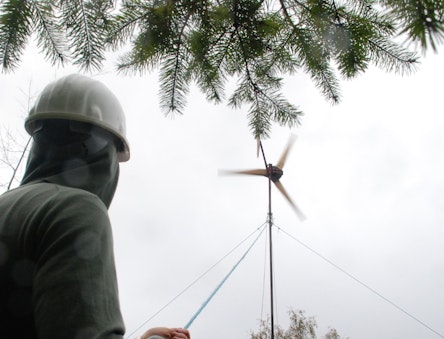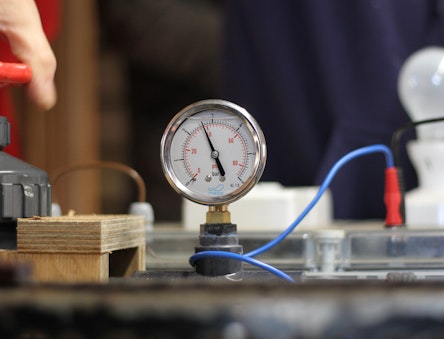
Battery Storage
We need energy storage and smart controls to reduce the use of gas-fired power stations. It will allow electricity from renewable energy to be stored and fed back to the grid at times of peak demand. Domestic battery storage is one way of helping with this – so what are the potential benefits and impacts of batteries?
Rising electricity prices mean that storing energy in a battery to use later will save you more money than it did a couple of years ago. This is making a battery a more attractive investment – although upfront prices are high.
You need to take a careful approach to be confident of a decent financial saving. We also need to be sure that the resources invested in manufacturing batteries do result in a worthwhile environmental benefit.
Thinking at the larger community scale is important. That’s because we need energy storage that can buffer the grid between off-peak and peak times. This will boost the use of renewable energy from wind farms and other sources. It’s therefore good to think more widely than just matching your own energy needs.
The best setup, environmentally and financially, will be one that allows you to charge the battery from the grid as well as from solar panels, and that allows you to export from the battery to the grid during chosen periods. Bear in mind that this should also enable you to get better payments for exporting electricity at peak times.
What’s the environmental impact of a storage battery?
Studies into the carbon footprint of current lithium-ion batteries for electric cars calculate a figure of around 100kg of carbon dioxide (CO2) per kilowatt-hour (kWh) of battery capacity when manufactured in factories that use fossil fuels. When renewable energy is used for the manufacturing this is reduced to about 60kg CO2 per kWh. See for example this analysis by Carbon Brief. Gradually decarbonising the supply chains for raw materials will further reduce the carbon emissions.
Developing new types of battery chemistry will also help. For example, the campaign group Transport & Environment recently reported the potential for solid state batteries to reduce the carbon footprint to below 50kg CO2 per kWh.
New developments should be alongside efforts to improve the recycling of lithium batteries and reduce the environmental and social impacts from extracting raw materials. We can achieve reduced costs and carbon emissions through improved processes, rather than from driving down labour costs or working conditions or creating other long term pollution problems.
Will a battery help to reduce carbon emissions?
In carbon terms, the most advantageous use of electricity storage in the UK is to help reduce the use of gas-fired power stations. That’s because we’ve already nearly eliminated the use of higher carbon coal-fired power.
Replacing 1kWh of electricity from gas will avoid emitting about 0.35 to 0.4 kg of CO2. A lithium-ion battery carbon footprint of 80kg CO2 per kWh is about 200 times as much as that. Therefore, for the carbon savings to outweigh the manufacturing impact the battery needs to be charged from zero carbon energy and discharged to replace gas power stations about 200 times.
That’s less than one year of use. Of course in practice not all output from a battery will be directly replacing gas. But it shows the potential for reducing carbon emissions through a combination of renewable energy and energy storage.
A key step to maximise carbon savings is therefore if your battery works as a buffer for the grid, rather than only meeting your own needs. For example, this could mean exporting to the grid in early evening, when demand for electricity is more likely to exceed what is being generated from renewable energy.
Ideally, a combination of smart controls and variable rate tariffs will enable you to receive a better export rate at times like that. This will make it more financially attractive to sell the power than to keep it for your own use.
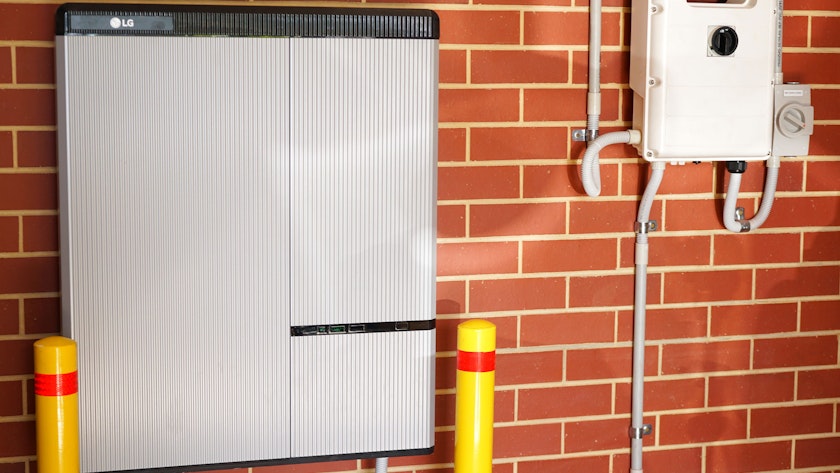
What’s the cost and lifespan of a domestic battery?
When comparing offers work out the price per kWh of storage capacity. Lithium-ion battery cost is often around £1000 per kWh of storage, but for larger capacity batteries it can be less – perhaps £700 per kWh. For example, a battery with a usable capacity of 10kWh might cost £7,000.
The expected lifespan of a battery is key to estimating the financial payback. A lithium-ion storage battery warranty is usually for either 10 years or a minimum amount of energy stored (‘throughput’), whichever is reached first. Comparing a few different batteries, the warrantied throughput is around 2500 to 3000 kWh per kWh of storage capacity.
The warranty should also describe the expected reduction in storage capacity over time. The capacity after ten years of use may be about 60% to 70% as much as when new. That means a battery that originally stored 5kWh would drop to about 3kWh capacity after a decade of use.
A battery could have a warranty covering the number of charging cycles. However, bear in mind that the reduction of storage capacity means that future cycles will be to a lower level of charge.
Battery life should be a bit longer than is warrantied, depending on usage. Despite this, the continued degradation means that the warrantied throughput could be a good figure to use when estimating financial savings.
What is the financial payback on a battery?
It’s hard to give a good estimate for the time needed to recoup the money spent on a battery. It will depend on the different prices available to you for importing and exporting electricity. It also depends on your level of electricity consumption. If you also fit a heat pump to heat your home, then a battery could give a lot more potential for reducing running costs.
Back when electricity prices were about 15 pence per kWh and you could export directly for a few pence per kWh, the net benefit of storing energy to use later may have been only £250 to £300 per kWh of capacity, over a full ten years of use. For someone on the feed-in tariff scheme the export rate will probably not be a factor. In that case the saving would have been about £100 to £150 more per year. Either way, that’s less than the battery cost.
Import prices went up a lot in the last few years, while export rates were usually still only a few pence. However, import prices are now dropping, and better export rates have also become more available. How much this will continue to change in the next ten years is very hard to say, so estimating long term financial benefits is tricky.
From July 2024 the price cap equates to an electricity cost of 22.36p per kWh, but may continue to drop. If the longer term saving is assumed at 20p per kWh, then storing 3000 kWh (over the battery life) to use later adds up to about £600. However, if you could have exported that electricity for say 10 to 15 pence per unit instead of putting it in a battery, the actual benefit would be less than £300 per kWh. Estimates like this can be compared to current battery costs per kWh of capacity, to see if the likely savings are bigger than the cost, or if the cost will not be recouped.
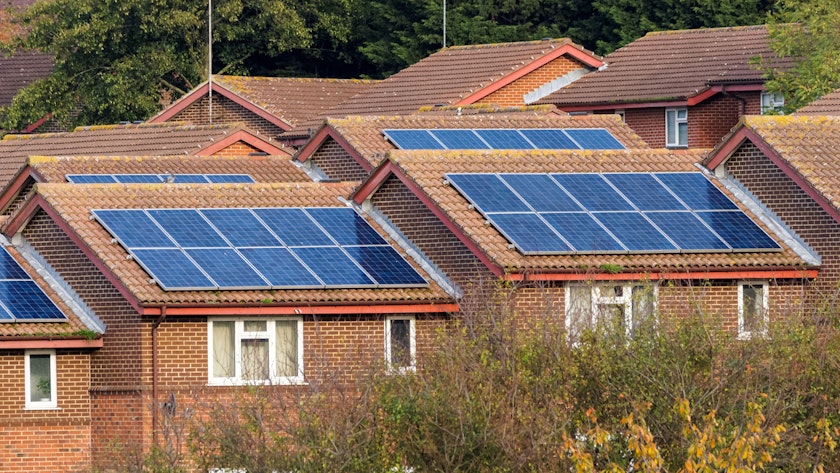
Getting a better return with smart imports and exports
Even with high import energy prices, to get a good financial payback from a battery you really need to make use of ‘time-of-day’ tariffs for importing and exporting energy at different rates during the day. And remember that this also ties in with the approach mentioned above for maximising carbon savings.
For example, with a battery you could avoid importing during the early evening peak. Instead, draw only from solar panels and/or battery at that time. Exporting excess energy to the grid at peak times can give a better payback than keeping it to use later. A combination of these should give a much better return than the payback calculated above – but exact savings will vary.
It’s important to get a reasonable export price for electricity generated from a solar PV array, because there will always be seasonal limits on how much you can use directly. In the UK summer a 4 kilowatt PV roof should produce about 15 to 20 kWh per day. This is about 2 to 3 times as much as average daily electricity use (or could be 4 or 5 time more than in a very energy efficient home). You will therefore be exporting most of this electricity – either directly, or later in the day via a battery. Exporting energy is good, as it all contributes to decarbonising the grid!
At the moment you need to be more careful when choosing and using a time-of-day tariff. Variable wholesale gas prices can mean that imports during peak periods could be at a very high cost.
Will a battery work during a power cut?
Most standard battery installations will cut off during a power cut. This is to avoid sending electricity out to the grid when engineers may be working on a fault. For most people this is fine, as they rarely get power cuts. A well-insulated home will retain heat for many hours until the power comes back on,
You can have a system that will run as an ‘island’ during a power cut. It just costs more money to put in the extra equipment to allow you to do this. You therefore need to weigh up that cost against the need to run your electrical appliances during a power cut. You may need to be more careful selecting the battery size, to ensure it has sufficient peak power output.
Vehicle to grid (V2G)
For electric vehicle (EV) owners, another option is to make use of the car battery as a buffer for the grid by using a charger with ‘vehicle-to-grid’ (V2G) capability. Car battery capacities are much higher than domestic batteries – even smaller cars will store about 40kWh. On a day when you’re not driving far you could charge on a cheap night rate or from your solar panels and sell back to the grid for a high rate.
At the moment you can only get a V2G charger through an approved trial. If interested, you could register with some energy providers and car manufacturers to get updates on these. More widespread deployment should be possible soon.
The main driver of V2G is the need to buffer grid demand at peak times. Exports will be triggered by a control unit that communicates with the grid, based also on the preferences you set. It is also going to be possible to have a vehicle-to-home approach with this sort of technology.
Further information
For some additional details, see our questions and answers section below.
Related Questions
Should I sign up for a green tariff?Signing up for a ‘green tariff’ from a company focused only on renewable energy is a great way to support the renewable energy industry. Changing your supplier is now very easy, and in most cases won’t make any difference to your supply.
One issue is that the small companies that specialise in renewable energy may not be part of the ‘Warm Home Discount’ scheme (although if they get enough customers they will be brought into it). This scheme gives a rebate to people at risk of fuel poverty, such as those receiving Pension Credit Guarantee Credit and some others. If this applies to you then you’ll need to stay with a larger provider to get this rebate.
Which green tariff?
We recommend choosing a company that only supports renewable energy. This means your money will not indirectly go to operate or build fossil-fuel power stations.
All electricity providers are required by the government to include some electricity from renewable sources. If they just offer a green tariff as one of a range of tariffs, then they may be simply charging a premium for electricity they’re legally required to produce! This is why we recommend companies that invest your electricity bill payments only in more renewable electricity.
If enough people sign up for renewable energy tariffs with these suppliers, then demand for renewable electricity will rise above the minimum government requirement. Therefore, as well as signing up yourself, encourage others to do the same.
The Ethical Consumer website gives a ranking based on the ethical and environmental record of electricity & gas suppliers. You have to be an Ethical Consumer subscriber to see the whole report, which gives more details.
I’m on a green tariff – so can I use as much electricity as I like?
It’s important to bear in mind that signing up to such a tariff does not mean you can leave all your lights on because it’s all zero carbon! If you use more electricity through your green tariff it means that less renewable electricity is left for those that are not on green tariffs. This means that more fossil fuel will be burned to meet their share of energy use.
Also, every means of generating electricity has some environmental impact, including the energy and materials that go into manufacture and installation. Energy saving measures are vital, because it’s them much easier to meet our electricity needs with energy sources such as wind farms, and wave & tidal power. Our Zero Carbon Britain project has a lot more details about how we can meet all our energy needs using only renewable energy.
If a grid connection is already in place or available close by, then it makes more sense to generate renewable energy and buffer it with the grid. There’s rarely a benefit in going off grid when you don’t need to.
However, in place where there’s no grid connection or it would be very expensive to connect, a small wind turbine and some photovoltaic (PV) solar panels can be a good alternative to a diesel generator (which will be noisy and polluting and have ongoing fuel costs).
If you’re off-grid and need power all year round, wind and solar complement each other well as there’s more wind in winter and more sun in summer. If you only need power in summer, you could get awaty with only using solar power.
Considerations for siting a wind turbine or solar photovoltaic panels are the same as with grid-connected systems, so see our pages on these. You need an unshaded and roughly south-facing site for solar, and somewhere with strong, consistent wind speeds for a turbine.
Sizing an off-grid system
If living off-grid you’ll need to store wind & solar powered electricity in batteries. To have sufficient electricity for your needs, you must first estimate how much electricity you’re likely to be using. You can do this by estimating the total energy consumption of all the electrical appliances you intend to run.
The power rating in watts (marked on the back of the appliance) multiplied by the time (in hours) that it will be used each day, gives the energy (in watt-hours) that you will need per day in order to run that appliance. Add all these figures up to see what size system you require.
The more energy you need, the bigger and more expensive the system becomes. Therefore, make sure you are using energy efficiently, and consider whether or not all the appliances are necessary. Fitting low-energy light bulbs and using other fuels for heating (perhaps wood fuel) and cooking will make a big difference to the overall cost.
Batteries
Batteries are essential in most off-grid wind or solar systems, but are expensive and will deteriorate. They store low voltage (up to 48V) DC electricity and need to be protected from over and under charging with a suitable controller. Lead-acid batteries were common in off-grid projects, but now lithium-ion are becoming more common. The latter have a longer lifetime but are more expensive – so lifetime costs may be similar.
Deep cycle batteries are preferable for renewable energy systems, as they are designed to have up to 80% of their charge repeatedly removed and replaced over a period of 5 to 15 years (or 1000 – 2000 times). Vehicle batteries are not suitable as they are designed to give a short burst of high current and be recharged immediately. They will perform poorly if allowed to discharge more deeply. Do make sure you follow proper safety procedures when dealing with batteries.
Inverters & Cables
To run some appliances you’ll need an inverter to convert from 12 volts DC to 230 volts AC. There are different types of inverters for grid-connected and off-grid systems. They can be expensive, and rise in cost as the maximum power that they need to be able to cope with increases, so it could be worth trying to run DC appliances where possible (for example, low-voltage lighting).
Solar PV panels and small wind turbines usually operate at low voltages (e.g. 12 or 24 volts). The voltage drop in wires can have a significant effect at these levels. Cables must be thick enough to minimise this drop and carry the required current. As cables are expensive, this can affect wind turbine siting.
Yes, this is possible if you have a hot water tank. The electricity produced by a PV array can be diverted to an electric immersion heater. This needs to be controlled by a diverter unit that only turns the heater on when the PV array is producing enough output (so that it doesn’t use any mains electricity instead)
How much money or carbon this saves will depend on how you would otherwise heat water, and the cost of the equipment.
If your household or building has a large demand for hot water, then solar water heating may be a better choice, because you get more hot water from a smaller area of panel.
Carbon Savings
The carbon savings due to diverting PV to heat water, instead of using a gas boiler, have changed as the UK grid has decarbonised.
Several years ago, electricity use resulted in higher carbon emissions per unit than mains gas. Therefore, letting surplus electricity flow out to the grid, where it reduced electricity use in neighbouring houses, led to a greater carbon reduction overall than diverting it to heat water instead of using a gas boiler.
However, the large amount of wind power we have now, plus some solar and hydro power, means that UK electricity now has lower emissions per unit than mains gas. Therefore diverting solar PV to heat water instead of using gas will lead to a better overall carbon reduction than exporting to the grid.
However, using a heat pump to heat water uses less electricity overall, and so you could argue that if you move to a heat pump it’s better to use that to heat water! Then the PV electricity can be left to either be used by the heat pump – if the water heating cycle (maybe one hour per day) happens to be at a sunny time of day – or exported to the grid if not needed.
Financial Savings
Diverting the solar PV output to heat water in your home could save you some money. The payback time would depend on the cost of the diverter compared to the annual savings possible.
For a family house, hot water heating might use about 4kWh per day. If about 4kWh per day could be diverted from solar panels for about two-thirds of the year (when it’s sunny enough), that would be about 1000 kWh per year.
Back when gas cost about 4p per kWh then that saving would be about £40. If the diverter cost about £400 then the payback time is roughly ten years. A cheaper diverter would pay back more quickly.
However, gas is currently much more expensive – at over 10p per kWh. Therefore savings can be more like £100 per year and payback is much quicker.
If you only have electricity available to heat your water, then the saving will depend on the price per kWh you pay. That could bevery high on a normal day rate, but less on Economy 7 or other off-peak tariffs.
Solar Water Heating
Using a solar water heating system, you’ll need about 1 square metre (1m²) of panel per person to meet the hot water demand in summer, so maybe 3 to 4m² for a family house. Using PV panels you would need about 3 or 4 times as much roof area to get the same energy output. It would take perhaps half of the daily summer output of a 3.5kW (25m²) PV system to heat a cylinder of water.
Having both PV and solar water heating would make the best use of available roof area. Ideally, we would be integrating these technologies into new-build homes wherever they are appropriate – to maximise the contribution of solar energy and reduce carbon emissions.
Related events


Introduction to Renewables for Households
13th September 2025
Renewables for Households: Insulation
8th November 2025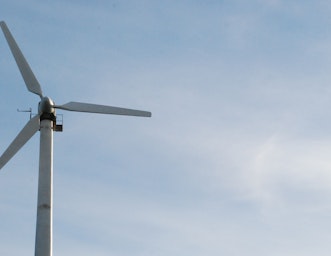
Renewables for Households: Wind Turbines
10th January 2026Study at CAT: Our Postgraduate Courses
Related news
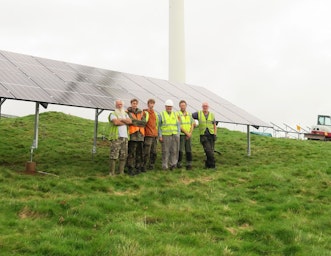
More solar energy for CAT
4th April 2025
CAT Conversations – Dr Frances Hill
10th July 2024
CAT Stories – Aber Food Surplus
23rd May 2024
Taking back power
9th April 2024
Related Short Courses: Energy
6th September 2025 Short Course Generate electricity with a homemade wind turbine. Join Tom Dixon of V3 Power to build a wind turbine yourself, from scratch. Drawing on over ten years of experience in teaching…
Read More13th September 2025 Short Course Rethinking household energy provision – bringing energy into your own greener hands. Where our energy comes from has a big impact, and to reach a Zero Carbon Britain it needs…
Read More8th November 2025 Short Course Rethinking household energy use – the importance of insulation. A lot of existing buildings in the UK are poorly insulated and draughty, resulting in loss of heat and higher energy…
Read More
Did you know we are a Charity?
If you have found our Free Information Service useful, why not read more about ways you can support CAT, or make a donation.
Email Sign Up
Keep up to date with all the latest activities, events and online resources by signing up to our emails and following us on social media. And if you'd like to get involved and support our work, we'd love to welcome you as a CAT member.

